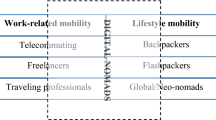Abstract
Maintaining mobility despite the bodily, mental, or monetary challenges which often come along with advanced age is a relevant aspect of the quality of live. The collaborative research project EMN-Moves provides assistive technology for initiating and coordinating mobility support in residential districts. Mobility support is seen as a social task involving the interplay of housing societies, social organisations and residents of different age groups—with and without special needs. The project focuses on two aspects: (1) a Geo-Wiki for documenting temporary mobility barriers and for generating proposals for alternative routes, (2) a matchmaking service for bringing together (elderly) people who need support with volunteers.






Similar content being viewed by others
Notes
Josef-Stifung Bamberg, GewoBau Erlangen, WBG Nürnberg.
OpenStreetMap, http://www.openstreetmap.org/.
References
Banerjee N, Chakraborty D, Dasgupta K, Mittal S, Nagar S et al. (2009) R-U-In?-exploiting rich presence and converged communications for next-generation activity-oriented social networking. In: Tenth International conference on mobile data management: systems, services and middleware (MDM’09). IEEE Press, New York, pp 222–231
Berle L (2012) Matching natural language activity descriptions by using self-expanding ontologies—an application to support mobility of elderly people. Bachelor thesis, Faculty Information Systems and Applied Computer Science, University of Bamberg
Cortes U, Barrue C, Martinez AB, Urdiales C, Campana F, Annicchiarico R, Caltagirone C (2010) Assistive technologies for the new generation of senior citizens—the SHARE-it approach. Int J Comput Health 1(1):35–65
Czaja S, Lee C (2004) Designing computer systems for older adults. Erlbaum, Hillsdale
Fenza G, Loia V, Senatore S (2008) A hybrid approach to semantic web services matchmaking. Int J Approx Reason 48(3):808–828
Flanagin A, Metzger M (2008) The credibility of volunteered geographic information. GeoJournal 72(3):137–148
Gagliardi C, Marcellini F, Papa R, Giuli C, Mollenkopf H (2010) Associations of personal and mobility resources with subjective well-being among older adults in Italy and Germany. Arch Gerontol Geriatr 50:42–47
Goodchild M (2007) Citizens as sensors: the world of volunteered geography. GeoJournal 69(4):211–221
Haklay M (2010) How good is volunteered geographical information? A comparative study of openstreetmap and ordnance survey datasets. Environ Plan B, Plan Des 37(4)
Hanson VL (2009) Age and web access: the next generation. In: Proceedings of the 2009 international cross-disciplinary conference on web accessibility (W4A). ACM, New York, pp 7–15
Haustein S, Kemming H (2008) Subjektive Sicherheit von Senioren im Straßenverkehr. Z Verk.sicherh 54(3):128–133
Martins MM, Santos CP, Frizera-Neto A, Ceres R (2012) Assistive mobility devices focusing on smart walkers: classification and review. Robot Auton Syst 60(4):548–562
Mollenkopf H (2005) Enhancing mobility in later life: personal coping, environmental resources and technical support, the out-of-home mobility of older adults in urban and rural regions of five European countries. Ios Press, Lansdale
Morenoa A, Vallsa A, Iserna D, Marina L, Borrásb J (2013) Sigtur/e-destination: ontology-based personalized recommendation of tourism and leisure activities. Eng Appl Artif Intell 26(1):633–651
Munz M, Stein K, Sticht M, Schmid U (2012) Matchmaking: how similar is what I want to what I get? In: 1st international workshop on similarity and analogy-based methods in AI (SAMAI), Toulouse, pp 13–18. Rapport interne IRIT/RR
Pollack M (2005) Intelligent technology for an aging population: the use of AI to assist elders with cognitive impairment. AI Mag 26(2):9–24
Priedhorsky R (2010) The value of geographic Wikis. PhD thesis, University of Minnesota
Raman R, Livny M, Solomon M (1998) Matchmaking: distributed resource management for high throughput computing. In: Proceedings of the seventh international symposium on high performance distributed computing,. IEEE Press New York, pp 140–146
Roche S, Mericskay B, Batita W, Bach M, Rondeau M (2012) Wikigis basic concepts: web 2.0 for geospatial collaboration. FutureManag-Update 4(1):265–284
Scheffer AC, Schuurmans MJ, van Dijk N, van der Hooft T, de Rooij SE (2008) Fear of falling: measurement strategy, prevalence, risk factors and consequences among older persons. Age Ageing 37(1):19–24
Scheiner J (2006) Does the car make elderly people happy and mobile? Settlement structures, car availability and leisure mobility of the elderly. Eur J Transp Infrastruct Res 6(2):151–172
Stein K, Schlieder C (2013) A geowiki for participatory mobility. In: Steenberghen T, et al. (eds) Proc. 16th AGILE int. conf. on geographic information science. Digital proceedings. http://agile.gis.geo.tudresden.de/web/index.php/conference/conference-2013
Subasi O, Reithner E (2012) Needs & motivations of senior travelers for AAL. In: Proceedings of the 5th international conference on pervasive technologies related to assistive environments (PETRA’12). ACM, New York, pp 11:1–11:4
van Dyk T, Renaud K, van Biljon J (2012) Moses—method for selecting senior mobile phones: supporting design and choice for the elderly. In: Proceedings of the South African institute for computer scientists and information technologists conference (SAICSIT’12). ACM, New York, pp 277–285
Whitty MT, Baker AJ, Inman JA (eds) (2007) Online matchmaking. Palgrave Macmillan, Basingstoke
Acknowledgements
We thank Lukas Berle and Jürgen Gegenfurtner who supported the implementation of our system in the context of their bachelor theses. Furthermore, we thank members of the senior citizen councils of Bamberg, Erlangen, and Nürmberg for helpful discussions.
Author information
Authors and Affiliations
Corresponding author
Additional information
This work is funded by BMBF grant 16SV5700K (Technology and Innovation), Cooperation project “Europäische Metropolregion Nürnberg macht mobil durch technische und soziale Innovationen für die Menschen in der Region” (EMN-MOVES).
Rights and permissions
About this article
Cite this article
Schlieder, C., Schmid, U., Munz, M. et al. Assistive Technology to Support the Mobility of Senior Citizens. Künstl Intell 27, 247–253 (2013). https://doi.org/10.1007/s13218-013-0254-3
Published:
Issue Date:
DOI: https://doi.org/10.1007/s13218-013-0254-3




